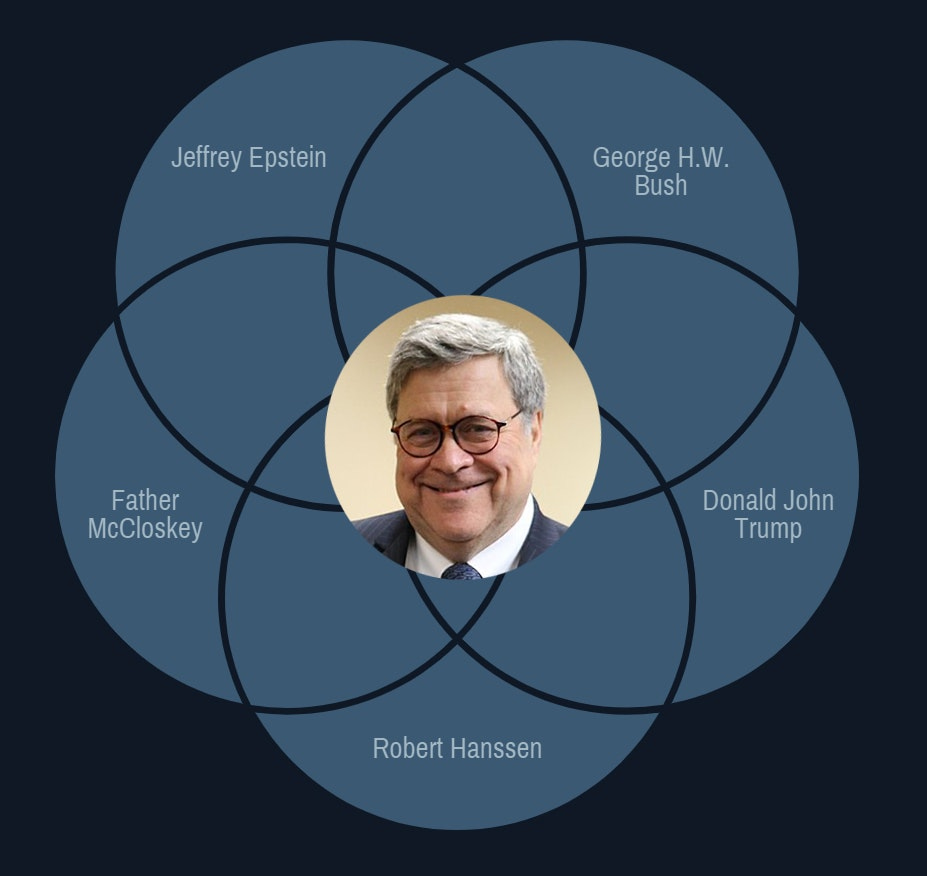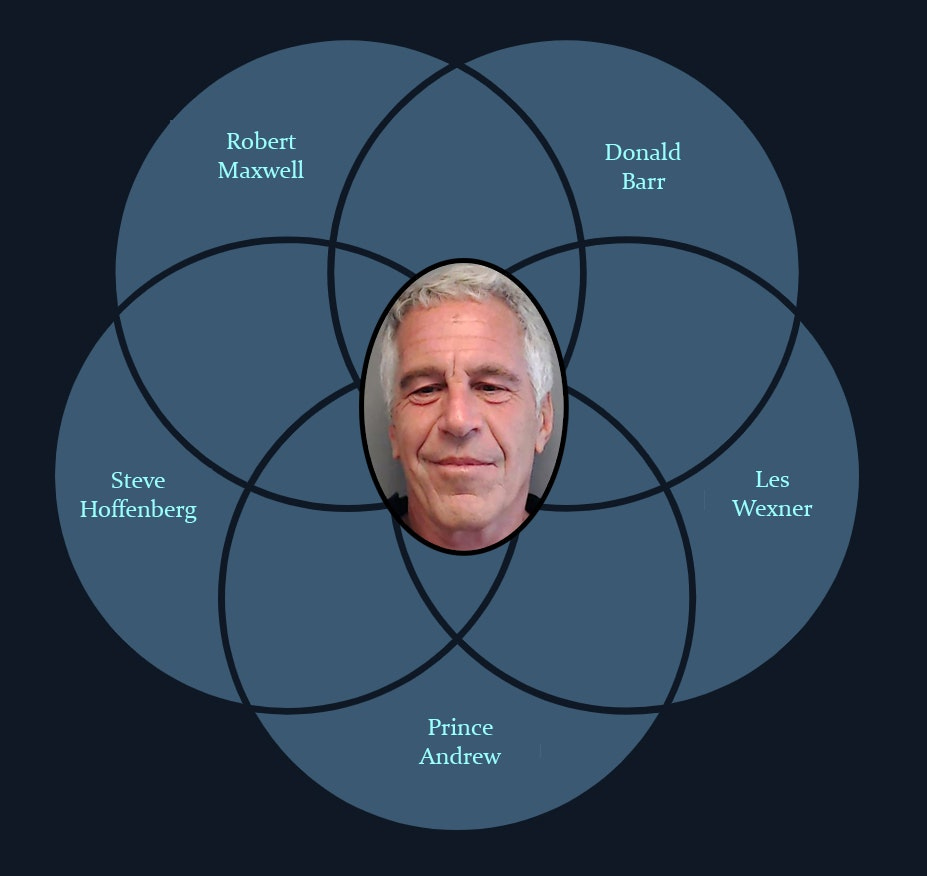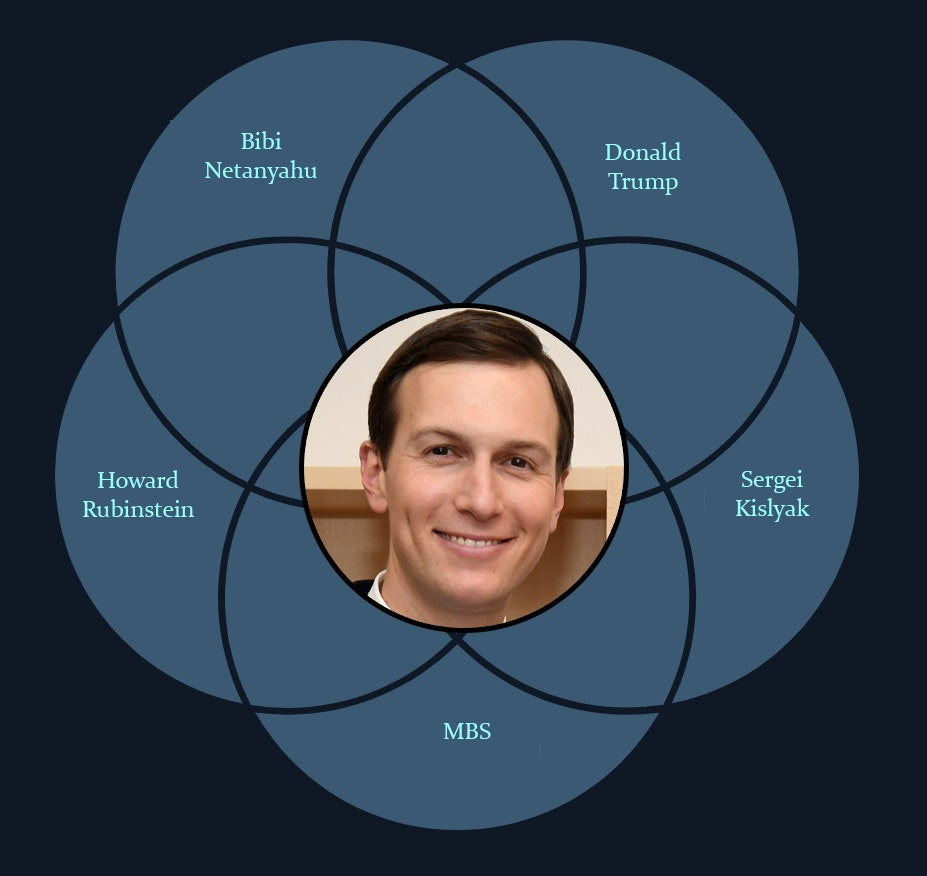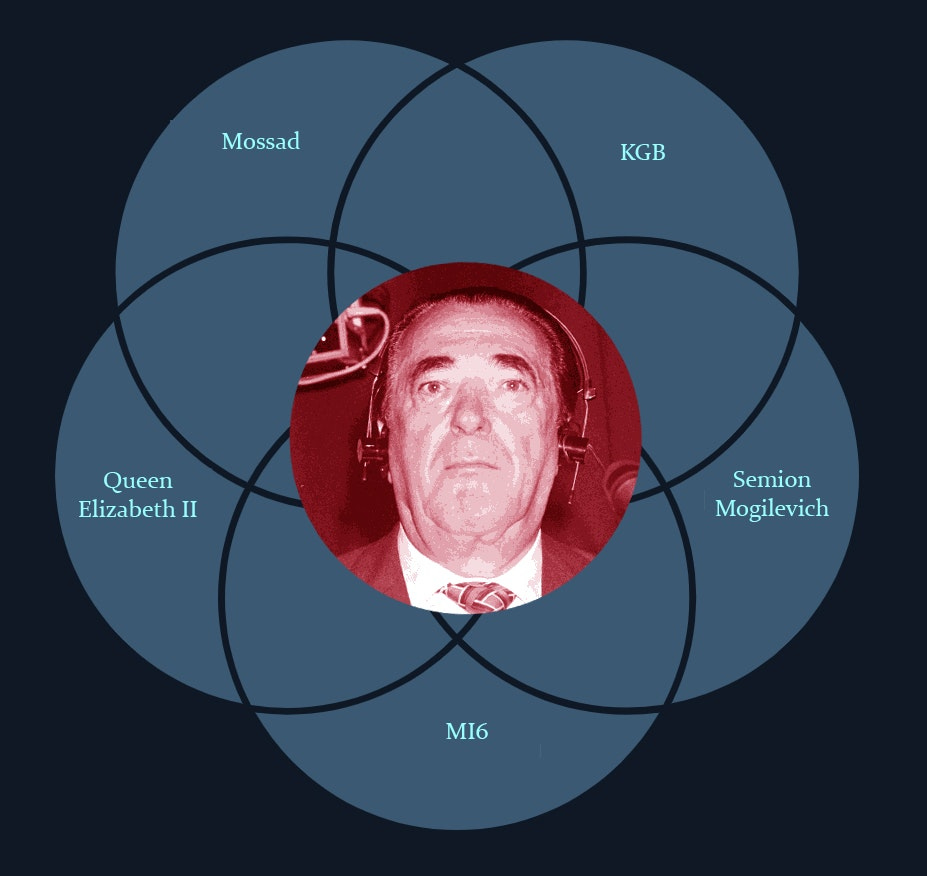Index: Men in the Middle
Powerful, enigmatic, shadowy men who occupy the center of the Venn diagram where many circles overlap.
Last summer, when The Former Guy was still president and the nation was closer to falling off the disintegrating ledge that we realized at the time, I found myself puzzled by Bill Barr. I couldn’t figure him out. Clearly he wasn’t working for the United States, but who was he working for?
To help myself process the data, I wrote about all of Barr’s odd connections: with Jeffrey Epstein; with the radical Opus Dei strain of the Catholic Church; with Robert Hanssen; with Iran Contra and BCCI, two enormous scandals of the 1980s that he helped bury. I don’t know that I solved the riddle, but the format was a helpful way to lay out information and help myself, and my readers, make connections that might not otherwise be apparent.
I wrote a handful of pieces using this formula, about the malefic men of mystery. Here is an index of those pieces:
Bill Barr
When hollow men in positions of great power do terrible things, chances are, William Barr is there to lend a helping hand.
For the last half century, Barr has been part Forrest Gump, part Winston Wolf—uncannily adjacent to key people and events, and always ready, willing, and able to help cover up the mess. In the Venn diagram of said people and events, he is the nexus, the Man in the Middle. And like the model Catholic warrior in his warped view of that great religion, he will hold the line until he dies.
What it all means, I can’t say. But this much is clear: everywhere we poke around in the dark underbelly of recent US history, it seems, we find Bill Barr, grinning like the Cheshire Cat, up to no good.
Jeffrey Epstein
Much like the high crimes and misdemeanors of Donald John Trump, the illicit activity practiced by the late Jeffrey Epstein is so sweeping, so vast, and so heinous, it’s difficult to fully absorb. This piece is an attempt to sort out the mess.
I have read a great deal about Epstein, including Vicky Ward’s profile in Vanity Fair, where all talk of her subject’s dalliances with underage girls was excised by her editor—presumably under pressure from Epstein himself. Over the last two weeks, I watched “Epstein: Filthy Rich,” the remarkable Netflix documentary, which mostly concerns sex trafficking, and listened to “Merchant of Death,” Zev Shalev’s even-more-remarkable series of broadcasts on his Narativ channel about Epstein’s career as an arms dealer and money launderer.
“Filthy Rich” is interesting because it shows the places where Epstein lived, the shitty art on his walls, his crappy taste in clothes and furniture. And it’s one thing to read about him trafficking underage girls, and quite another to meet them and see pictures of what they looked like while he was abusing them. The man was a monster. “Merchant of Death,” meanwhile, delves into the under-reported, but possibly more critical, aspect of Epstein: his pocketbook. Who was this guy, and how’d he get so rich?
Shalev has an epiphany during his broadcast. Epstein, he explains, is really three things: First and foremost, an arms dealer; second, a money launderer and Ponzi schemer; third, a sex trafficker. When we think of Epstein in those terms, he becomes easier to understand.
Roger Stone
Stone is, in a word, a character. He dresses like a DC Comics supervillain. He has a tattoo of Richard Nixon between his shoulderblades. He has unorthodox sexual proclivities. He is engaging and glib when he appears on talk shows. He is a ratfucker, a master practitioner of the political dark arts: a dirty trickster, the Loki of the right.
He will do, and has done, almost anything that pops into his twisted mind to win his candidate an election—other than, you know, endorse a non-shit candidate and run an honest campaign. Court orders don’t silence him. Politesse doesn’t constrain him. Looming incarceration hasn’t slowed him down. He is the raging id of the Republican party.
For almost half a century, Stone has operated in the shadows of Republican power, like Jack the Ripper. He’s had an outsized, and adverse, impact on the history of our country. As my friend Mr. Robinson put it:

During his long and nasty career, he’s rubbed elbows with almost everyone.
Jared Kushner
On July 21, 2017, in a piece provocatively titled “Compromised: Is Jared Kushner Working for Vladimir Putin,” I offered these thoughts on Donald John Trump’s son-in-law and most important advisor:
It’s tempting to regard Jared Kushner as a little twerp, an undeserving nebbish who somehow gets to boink Ivanka and also run the country. Certainly the idea that this guy can bring peace to the Middle East and also end the U.S. opioid crisis is ridiculous. But what if Trump had good reason to give him the heavy lifting? What if Jared Kushner is far and away the most competent person in the White House? What if he can actually get shit done? And what if he’s working for the Russians?
Most of the attention on “RussiaGate” has focused on Trump, and rightly so. Trump’s Russia ties are as long as the ones around his neck, and fishy as all get out. The President is so loud, and demands so much of the spotlight, that an unassuming eminence grise like Kushner can operate in the shadows with impunity. This is troubling, because we have no clue where his allegiances lie. For all we know, Jared Kushner is the greatest threat to national security since Julius & Ethel Rosenberg. Certainly he should be viewed as such until we know for sure.
As with most of my early attempts at news analysis, I got some things right in that piece, and plenty wrong. While Jared Kushner was happy to work with the Russians when his interests and theirs were aligned, I do not believe he was working for Vladimir Putin. Boy Plunder, it seems to me, operates exclusively out of self-interest. He spent his time in the West Wing 1) righting the ship of the Kushner family business, and 2) lining his pockets as much as possible—as if he were the son-in-law of Azerbaijan’s Heydar Aliyev or Kazakhstan’s Nursultan Nazarbayev, and not the American president. Kushner proved willing to lie, cheat, steal, and even kill to fulfill his ambitious aims. Certainly he banked beaucoup bucks while in the White House.
I’m not sure if Kushner was “far and away” the most competent individual in the White House, but he was definitely reliable. Vanity Fair’s Katherine Eban, who wrote the bombshell stories exposing Kushner’s malfeasance during the early days of the pandemic, told me that he was regarded in most circles as the one guy in Trump’s inner circle who was effective. Certainly he knew how to work the WhatsApp and the Rolodex.
But here we are, six years removed from him officially joining the Trump campaign, and Jared Kushner is no less an enigma than he was in November of 2015. What do we really know about him? Heck, I’m not even sure he boinks Ivanka, as I cringeally joked in that piece. He bears an uncanny resemblance to the powerful “beardless men,” the eunuchs, who once ran the Byzantine Empire: tall, long-limbed, hairless, high-voiced, and absolutely fucking ruthless.


To solve the riddle of Jared Kushner, it’s instructive to see where he sits in the Venn diagram.
Robert Maxwell
Ghislaine Maxwell, the (“alleged”) sex trafficker and god knows what else, is the subject of a new book, a new documentary, and at least two new podcasts. But as inscrutable as she appears, it’s her old man who was the real riddle.
Abrahaim Lein Hoch was born on June 10, 1923, in Slatinské Doly, a nothing little town in that neglected part of Eastern Europe where Ukraine, Romania, Slovakia, Poland, and Hungary converge. Now it is part of Ukraine; a century ago, it was on the eastern marchlands of Czechoslovakia.
His parents were Orthodox Jews, and he grew up speaking Yiddish. Mechel Hoch and the former Hannah Slomowitz had seven children. Two did not survive childhood; four others did not survive the war. When Hungary was occupied by the Nazis in 1944, Mechel, Hannah, and their children were sent to Auschwitz, where they died. The family’s lone survivor was Abrahaim, the second child and oldest son, who had already left his flyspeck of a hometown to fight the Nazis.
In his adventures in the war, he was known by many names: Abraham Hoch. Ján Abraham Ludvík. Jan Ludvick. Ivan du Maurier. Leslie du Maurier. Leslie Jones (!), an alias he used when interrogating Nazi prisoners of war. It was not until 1948—three years after the German surrender, and a year after his arrival in Britain from Berlin, that nest of spies where the British Foreign Office had posted him in the aftermath of the war—that he formally changed his name to the one by which the world would come to know him: Robert Maxwell.
As Kirby Sommers writes in her fascinating new book, Ghislaine Maxwell: An Unauthorized Biography, Maxwell was given two pieces of advice by his beloved mother: 1) Behave like an English gentleman, and 2) Don’t tell anyone you’re Jewish. Taken together, the message from Hannah Hoch could be distilled to this: Never show your true self.
And Robert Maxwell never did. The guy was a funhouse mirror. He was enough of a gentleman that he hobnobbed with the Queen and the royal family, but he was also, as one of his detractors put it, “a peasant.” He was a Jew who relished the killing of Nazis, but he was also an inglorious bastard. He loved his mum but hated women. He was a socialist and Labour Party MP who swindled his employees out of millions of pounds. His wealth, like so much about him, was an illusion, a shell game.
Even his death is shrouded in mystery. All we know is that in the wee hours of November 5, 1991, not long after ending a phone call with his son, he wandered out on the deck of his yacht, the Lady Ghislaine, and either fell or was pushed into the sea, where he drowned. He was naked, as he liked to be. Maybe he’d had a few cocktails. We don’t know if the Kidon got him, or if he fell overboard while taking a leak. Both explanations are plausible.
What we can say for sure is that Robert Maxwell—scrappy survivor, superspy, social climber extraordinaire, and scoundrel of all scoundrels—is perhaps the ultimate Man in the Middle, occupying the nexus where many different worlds intersect.
These are not the only “men in the middle,” of course. There are plenty more: Tom Barrack, Erik Prince, Steve Bannon, and Rod Rosenstein, to name but four. We’ll be looking at them in greater depth in the weeks ahead.







Greg, your work is incredible. Writing about history from the distance of years is one thing; writing about living history without getting lost in the weeds is another. Kudos. And a question: you are spending so much time with malevolence, perfidy, greed (fill in more) - I hope you have a strong suit of armor to protect you from losing your faith in the essential goodness of humans. At least a very large part of humanity. Stay safe!
I'm looking forward to more Venn diagrams with "men" in the middle...any women?